ABSTRACT
The initiation and intensity of warm rain are processes dominated by the evolution of cloud droplet spectra. To treat the cloud condensation process properly is a fundamental step for the simulation of warm rain formation. Double-moment bulk schemes with a limited number of prognostic variables cannot simulate the evolution of droplet spectra properly. A triple-moment bulk scheme, however, should overcome the problem of spurious cloud droplet spectrum broadening induced by double-moment schemes. To compare the effects of a newly developed triple-moment scheme with double-moment schemes on warm rain formation, the authors conducted WRF-LES numerical simulations to investigate the impacts of the two types of condensation scheme on rain initiation and intensity. In the early stage of raindrop formation, the simulation with the triple-moment scheme delays the raindrop initiation and produces droplet spectra with smaller average radii than those with the double-moment scheme. In the developing stage, the triple-moment scheme reduces the raindrop water content at the precipitation center. However, the further triple-moment scheme for raindrop is needed to simulate the development of warm rain accurately.
Graphical Abstract
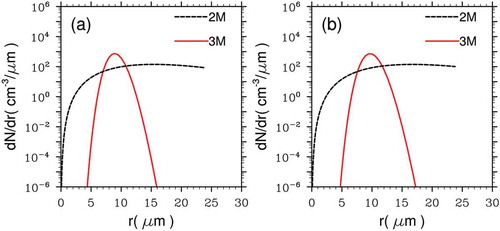
摘要
在暖云发展过程中,云滴谱的凝结不仅为对流提供能量而且直接影响暖雨的形成和发展。目前国际上广泛使用的云滴谱凝结方案主要为双参数方案,此类方案模拟的云滴谱在凝结过程中呈不正常拓宽现象,三参数云滴谱方案有效解决了该问题。为了比较两种凝结方案对暖雨初始形成和发展强度的影响,本文采用WRF模式中的理想性大涡模拟个例在相同背景条件下,分别使用两种方案模拟了一个对流热泡中暖雨的形成、发展过程。模拟结果表明:在雨滴初始形成阶段,三参数方案因为克服了双参方案中的拓宽问题,推迟了暖雨形成的时间;在暖雨发展阶段,三参数凝结方案有效削弱了暖雨区的中心强度;但在暖雨发展后期,两个凝结方案模拟结果的差异逐渐缩小。
1. Introduction
Precipitation produced by warm clouds normally takes place below the 0°C layer, without the occurrence of freezing microphysical processes. Warm rain is a typical precipitation process for some continental and maritime convective clouds. Raindrops are formed through water vapor diffusion growth for cloud droplets, and subsequent collision and coalescence. The description of such microphysical processes by bulk parameterization schemes determines the prediction of warm rain intensity and initiation in regional numerical weather models.
The evolution of cloud droplet spectra during condensation is a fundamental step for warm rain formation. The size distributions of cloud droplets in bulk schemes are described by a three-parameter gamma equation in the form of . The cloud droplets spectrum can be determined by three variables, where n(r) is number concentration of cloud droplets of radius r, N0 is intercept parameter of size distribution and β is slope parameter, the shape parameter α represents width of spectrum. The evolution of a droplet spectrum can be prescribed by the prognostic parameters (N0, α, β) during water vapor diffusion growth (Clark Citation1974). Theoretically, these parameters should be predicted by their respective exact differentials in all kinds of microphysical and dynamical processes through solving three prognostic equations of moments of the cloud droplet size distribution.
Current two-moment bulk schemes of cloud droplets use just two prognostic variables, droplet number concentration and cloud water content, to predict the evolution of parameters N0 and β. The value of the shape parameter (α) is kept constant to limit the number of prognostic variables (Morrison and Pinto Citation2005; Phillips, Donner, and Garner Citation2007). However, the width of the cloud droplet spectrum, which is closely related to α, observed in-situ, varies depending on the cloud type (maritime, continental, urban), and even within the same type (e.g. cumulus) at different heights. Undoubtedly, using a fixed parameter cannot describe the evolution of cloud droplet distributions properly during the condensation process. Zhang (Citation2015) compared the simulations results of different bin and bulk schemes, and found that using a double-moment scheme leads to an abnormal broadening problem that overestimates cloud droplets sizes.
Exaggerated cloud droplet radii is a problem that affects warm rain formation directly, since the raindrop water content in current bulk schemes is diagnosed through autoconversion and accretion rate equations that consider several characteristics of the cloud droplet spectra, such as cloud water content, spectrum width, and mean sizes (Berry and Reinhardt Citation1974; Phillips, Donner, and Garner Citation2007), and the evolution of cloud droplet spectra has a significant effect on the simulation of rain initiation and intensity (Cohard and Pinty Citation2000; Chen and Liu Citation2004; Lim, Donner, and Garner Citation2007).
To overcome the deficiency of double-moment schemes, a triple-moment bulk scheme, referred to as IAP-LACS, has recently been developed at the IAP’s Laboratory of Cloud-Precipitation Physics and Severe Storms (LACS), that includes an additional prognostic variable of the average radius. The triple-moment bulk scheme eliminates the problem of abnormal broadening of the cloud droplet spectrum in double-moment schemes, and can describe the evolution of droplet spectra more accurately during water vapor diffusional growth (Deng Citation2018). However, to what extent this new scheme affects the process of warm rain formation has yet to be simulated.
The numerical tests in this study focus on the effect of condensation schemes on warm rain formation. We separately simulate a marine-type shallow convective cumulus cloud system with the new triple-moment scheme and a double-moment scheme. The large eddy simulation (LES) idealized case in the Weather Research and Forecasting (WRF) model is applied in our simulations.
2. Methods
2.1 Microphysics schemes
The microphysics of warm clouds includes droplet nucleation from cloud condensation nuclei, water vapor diffusional growth (condensation and evaporation), and warm rain formation (autoconversion and accretion of cloud water). Both schemes use the same aerosol activation and raindrop formation algorithms. The aerosol activation scheme uses a log-normal distribution (Abdul-Razzak and Ghan Citation2000) to represent the size distributions of aerosols, and the activated aerosol number concentration is calculated through estimating the critical supersaturations of the aerosols with a Köhler curve and environment grid supersaturations (Deng Citation2018). The scheme for warm raindrop formation is from Phillips, Donner, and Garner (Citation2007), which itself was based on Lin, Farley, and Orville (Citation1983). The improved threshold value for autoconversion considers cloud droplet masses with larger radii (r > 8 μm), and then the initiated raindrop water content is calculated by the cloud droplet number and content (Khairoutdinov and Kogan Citation2000). The accretion rate depends on the breadth and average size of the cloud droplet spectra effecting collision efficiencies, besides cloud liquid mass.
The only difference in the microphysics lies in the water vapor diffusional growth for cloud droplets. The double-moment condensation scheme is the same as that of Phillips, Donner, and Garner (Citation2007), i.e. the increment of raindrop water content comes from the solutions to ordinary differential equations for the mixing ratio of water vapor and temperature, whilst at the same time the cloud droplet number and shape parameter (α) remain constant. The evolution of cloud droplet spectra results only from the increase in the slope parameter (β).
Based on Clark (Citation1974), the triple-moment scheme predicts the time derivation of the shape parameter in cloud droplet spectra by using a prognostic variable: the average radius of the cloud droplet spectrum. Besides, the newly developed condensation scheme uses a new numerical algorithm to ensure stability of the integration. A detailed description of the newly developed triple-moment condensation scheme is presented in Deng (Citation2018), and the two parameters (N0, β) of the droplet spectrum are derived from a combination of the mixing ratio of cloud water mass and the droplet number concentration. The triple-moment condensation scheme overcomes the problem of abnormal broadening and accurately describes the evolution of cloud droplet spectra.
After each conversion step, the cloud droplet spectra should be recalculated using three prognostic variables according to the treatment of Phillips, Donner, and Garner (Citation2007). The shape parameter (α) also remains constant in the rain conversion process, and the value of β should be updated in each time step.
2.2 Initial conditions
The initial thermodynamic conditions for all simulations are provided by the atmospheric profiles of temperature and dew point temperature from the RICO (Rain in Cumulus over the Ocean) observational experiment (Stevens and Seifert Citation2008). Horizontal wind is not considered. These profiles represent typical thermodynamic conditions for warm rain formation (Deng Citation2018).
The dynamical framework of WRF-LES is applied in this study. The simulation domain is 12 km × 12 km, and the cloud top height is 5 km. Convection is triggered by a spherical hot bubble at the center of the horizontal area. The heating temperature of the center is 3.0 K higher than the background, and the bubble radius is 300 m. The heating temperature decreases along the bubble radius. The simulation time for convection is set to 20 min. Both the vertical and horizontal resolution is 100 m.
3. Results
During the developing stage of convective cloud, there are cloud droplets with large radii around the cloud top for water vapor diffusional growth. The maximum value of cloud water content triggers warm rain initiation in the center of the cloud top, and the cloud water accretion accelerates raindrop formation around due to the increase in the average size of cloud droplets. When raindrop formation is mature enough, warm rain falls to the ground. The development of raindrop water content is closely associated with the evolution of the cloud water content and the average size of cloud droplets. We divide the development of warm rain into the initial formation stage, developing stage, and mature stage.
The simulation results presented below include the spatial distribution of the cloud water content, the average radius of cloud droplets, and the raindrop water content. All the results are from a cross section along the center of south and north axis of the hot bubble. The vertical coordinate is altitude and horizontal coordinate represents west and east axis of horizontal panel in three-dimensional model.
3.1 Raindrop initiation of warm rain
The initiated raindrops appear near the center of the cloud top at 7 min. The spatial distributions of cloud water content are similar in the triple- and double-moment schemes, as can be seen from . The maximum values of cloud water content in both cases is 1.2 g kg−1 at the center of the hot bubble. However, the droplet average radii are significantly different; the maximum average radius of the triple-moment scheme is no more than 15 μm, while the value of the double-moment scheme exceeds 20 μm. The overestimated average radii is indicative of the abnormal broadening problem in double-moment schemes. The radius growth rate of the cloud droplet is inversely proportional to the droplet radius during condensation. As a result, the widths of droplet spectra become increasingly narrower; and theoretically, the average radii of cloud droplets cannot exceed 20 μm through water vapor diffusion.
Figure 1. Spatial distributions of the mixing ratios of the (a, b) cloud water content (Qc) and, the (c, d) average radii of cloud droplets (Rc) and, the (e, f) rainwater content (Qr) simulated by the (a, c, e) triple-moment scheme (3M) and (b, d, f) double-moment (2M) scheme at 7 min.
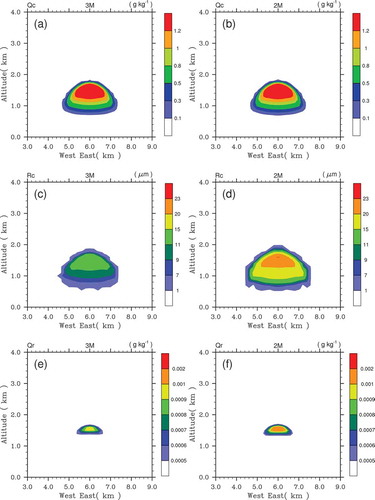
With large enough values of cloud droplet mass and the average size reaching the threshold values for cloud water autoconversion, raindrops initiate near the center of the cloud top at the height of 1.5 km, when the raindrop water content exceeds 10−3 g kg−1. At 7 min, the maximum value of rainwater content is 0.0009 g kg−1 in the triple-moment scheme; meanwhile, the maximum value in the double-moment scheme is 0.002 g kg−1, and raindrop initiation appears earlier. The smaller values of average sizes simulated by the triple-moment scheme delay the warm rain initiation.
The obvious difference in average radius and raindrop initiation results from the difference in the simulated size distribution of droplets between the two condensation schemes, as shown by . The results of the cloud droplet spectra in the center grids at 1200 m and 1500 m, respectively, show the breadth of cloud droplets become broadened from the lower height to the cloud top with an increase in cloud water content in the two condensation schemes.
Figure 2. Size distributions of cloud droplets of the triple-moment scheme (3M) and the double-moment (2M) scheme at (a) 1200 m and (b) 1500 m at 7 min.
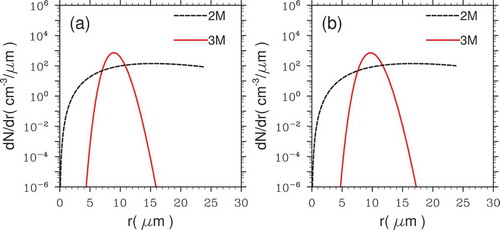
The main difference is that the size distributions of cloud droplets in the triple-moment simulation are narrow and unimodal, while abnormal broadening spectra arise for the double-moment simulation and lead to overestimated average radii.
The triple-moment condensation scheme overcomes the abnormal broadening problem of cloud droplet spectra in the double-moment condensation scheme. The narrower widths of spectra reduce cloud water autoconversion rates and then delay raindrop initiation.
3.2 Developing stage of warm rain
At 14 min, convection develops rapidly due to latent heat release (). The cloud water content increases and reaches a peak value of 3.5 g kg−1. also shows that the values of the average radii are higher in the double-moment simulation than those in the triple-moment simulation. The maximum average radius of the triple-moment is 18 μm, while that of the double-moment scheme exceeds 30 μm. Such a big difference results in various cloud water accretion rates, which depend on the average size and cloud water mass of larger cloud droplets. Narrower breadths of cloud droplet spectra reduce accretion rates for the triple-moment scheme, while the broadening of cloud droplet spectra results in higher rates in the double-moment scheme.
Figure 3. Spatial distributions of the mixing ratios of the (a, b) cloud water content (Qc) and, the (c, d) average radii of cloud droplets (Rc) and, the (e, f) rainwater content (Qr) simulated by the (a, c, e) triple-moment scheme (3M) and (b, d, f) double-moment (2M) scheme at 14 min.
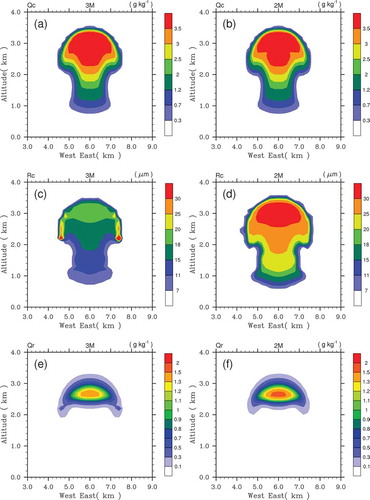
The large values of cloud water content and the mean sizes of droplets are helpful to exceed the threshold values of rain conversion. Thus, warm rain develops rapidly around the center of the cloud top, with the mixing ratio of rainwater content reaching 1.0 g kg−1 ( and ). The maximum mixing ratio of raindrop water content for the triple-moment scheme is about 1.3 g kg−1, while the peak value can reach 2.0 g kg−1 in the double-moment scheme. The evolution of the droplet spectra can affect the maximum intensity at the precipitation center (Zhou, Zhao, and Qin Citation2005). Therefore, the narrow droplet spectra of the triple-moment scheme can avoid overestimating the warm rain center intensity.
It should be noted that warm rain formation is based on the double-moment scheme. Consequently, the shape parameter remains constant for the triple-moment scheme during warm rain formation, such that cloud water conversion reduces the accuracy of the simulated cloud droplet spectra.
3.3 Mature stage of warm rain
The top of the fully developed convection reaches a height near 4 km at 17 min (), at which point the warm rain becomes mature. The decline of the mixing ratio of cloud water content indicates that warm rain formation accelerates below 3.5 km through effective autoconversion and accretion. The maximum value of the mixing ratio of the rainwater content reaches 6.0 g kg−1. The falling raindrops appearing on both sides of the cloud is due to the divergence of the cloud top vortex. Around cloud edges, there are peak values of average radii on both sides (). The entrainment accelerates the evaporation of cloud droplets. The reduction in small cloud droplets is obvious, because the evaporation rates of small droplets are larger than big ones, and the remaining small amount of cloud droplets with large radii increase the average radii values.
Figure 4. Spatial distributions of the mixing ratios of the (a, b) cloud water content (Qc) and, the (c, d) average radii of cloud droplets (Rc) and, the (e, f) rainwater content (Qr) simulated by the (a, c, e) triple-moment scheme (3M) and (b, d, f) double-moment (2M) scheme at 17 min.
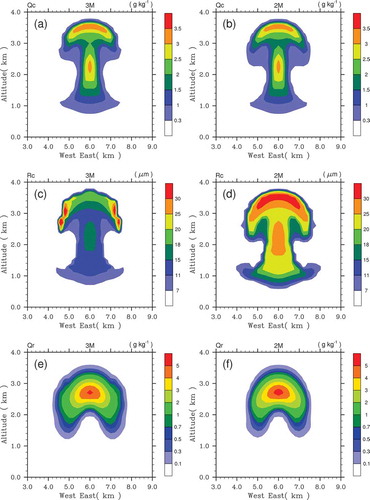
Although the mixing ratios of the rainwater center in the triple-moment scheme are smaller than those of the double-moment scheme at the height of 2.6 km, the difference between the two condensation schemes decreases as the warm rain becomes mature. At 20 min, there is no significant difference in the spatial distributions of the two simulation results when precipitation reaches the ground (). Meanwhile, most of the cloud water content turns to be warm rain, and the whole cloud dissipates.
Figure 5. Spatial distributions of the mixing ratios of the rainwater content (Qr) simulated by the (a) triple-moment scheme (3M) and (b) double-moment (2M) scheme at 20 min.
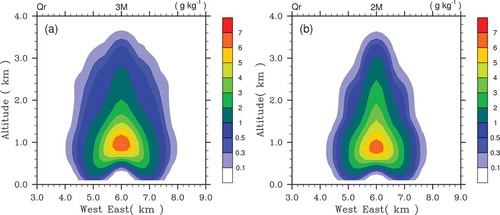
Cloud droplet condensation schemes affect warm rain initiation and center intensity evidently in the developing stage of warm rain, but such impacts become weak as the warm rain becomes mature. The reasons may be that current rain parameterizations are unable to accurately estimate the conversion rate of cloud water for triple-moment cloud parameterization schemes. These less proper conversion processes reduce the effects of cloud droplets condensation on warm rain formation when collision plays a more important role in warm rain development.
4. Conclusions
To study the effects of a newly developed triple-moment scheme on warm rain formation, we conduct marine-type shallow cumulus numerical tests and compare the simulation results of the triple-moment cloud scheme with those of a double-moment scheme. The triple-moment cloud scheme overcomes the abnormal spectrum broadening problem of the double-moment scheme, delays the formation of warm rain, and even reduces the rainfall intensity. However, such differences tend to become negligible as the convection develops.
When warm rain falls to the ground, no obvious difference is observed between the simulated results of the two schemes, which can probably be attributed to the fact that the two cloud schemes both use the same double-moment rain parameterization. In the future, we hope to develop a new triple-moment rain parameterization scheme and couple it with the IAP-LACS scheme to further elucidate the advantages of triple-moment parameterization schemes in the simulation of warm rain formation.
Disclosure statement
No potential conflict of interest was reported by the authors.
Additional information
Funding
References
- Abdul-Razzak, H., and S. J. Ghan. 2000. “A Parameterization of Aerosol Acitvation.2. Multi Aerosol Types.” Journal of Geophysical Research 105 (D5): 6837–6844. doi:10.1029/1999JD901161.
- Berry, E. X., and R. L. Reinhardt. 1974. “An Analysis of Cloud Drop Growth by Collection: Part 2. Single Initial Distribution.” Journal of the Atmospheric Sciences 31: 1825–1831. doi:10.1175/1520-0469(1974)031<1825:AAOCDG>2.0.CO;2.
- Chen, J.-P., and S.-T. Liu. 2004. “Physically Based Two-Moment Bulk Water Parametrization for Warm-Cloud Microphysics.” Quarterly Journal of Royal Meteorological Society 130: 51–78. doi:10.1256/qj.03.41.
- Clark, T. L. 1974. “A Study in Cloud Phase Parameterization Using the Gamma Distribution.” Journal of the Atmospheric Sciences 31: 142–155. doi:10.1175/1520-0469(1974)031<0142:ASICPP>2.0.CO;2.
- Cohard, J.-M., and J. P. Pinty. 2000. “A Comprehensive Two-Moment Warm Microphysical Bulk Model Scheme: I: Description and Tests.” Quarterly Journal of Royal Meteorological Society 126: 1815–1842. doi:10.1256/smsqj.56613.
- Deng, W. 2018. “Numerical Simulations for Cloud Droplet Diffusion Growth with a Newly Developed Triple-Moment Scheme.” PHD. Dissertation (in Chinese), Institute of Atmospheric Physics, University of Chinese Academy of Sciences, 104.
- Khairoutdinov, M. F., and Y. L. Kogan. 2000. “A New Cloud Physics Parameterization in A Large-Eddy Simulation Model of Marine Stratocumulus.” Monthly Weather Review 128: 229–243. doi:10.1175/1520-0493(2000)128<0229:ANCPPI>2.0.CO;2.
- Lim, V., L. J. Donner, and S. Garner. 2007. “Nucleation Process in Deep Convection Simulated by a Cloud-System-Resolving Model with Double-Moment Bulk Microphysics.” Journal of the Atmospheric Sciences 64: 738–761. doi:10.1175/JAS3869.1.
- Lin, Y.-L., R. Farley, and H. Orville. 1983. “Bulk Parameterization of the Snow Field in a Cloud Model.” Journal of Applied Meteorology 22 (6): 1065–1092. doi:10.1175/1520-0450(1983)022<1065:BPOTSF>2.0.CO;2.
- Morrison, H., and J. O. Pinto. 2005. “Mesoscale Modeling of Springtime Arctic Mixed-Phase Stratiform Clouds Using a New Two-Moment Bulk Microphysics Scheme.” Journal of the Atmospheric Sciences 62: 3683–3704. doi:10.1175/JAS3564.1.
- Phillips, V., L. J. Donner, and S. Garner. 2007. “Nucleation Process in Deep Convection Simulated by a Cloud-System-Resolving Model with Double-Moment Bulk Microphysics.” Journal of the Atmospheric Sciences 64: 738–761. doi:10.1175/JAS3869.1.
- Stevens, B., and A. Seifert. 2008. “Understanding Macrophysical Outcomes of Microphysical Choices in Simulations of Shallow Cumulus Convection.” Journal of the Meteorological Society of Japan 86: 143–162. doi:10.2151/jmsj.86A.143.
- Zhang, J. 2015. “The Comparison of Methods for Droplets Growth by Condensation.” M. S. thesis (in Chinese), Lanzhou University, 48. doi:10.1128/AEM.03322-14.
- Zhou, G. Q., C. S. Zhao, and Y. Qin. 2005. “Impact of Cloud Droplets Spectral Uncertainty on the Mesoscale Precipitation.” Journal of Tropical Meteorology (in Chinese) 21 (6): 605–614. doi:10.16032/j.issn.1004-4965.2005.06.006.
